|
|
|
|
|
Oil On
Canvas, Real Flavor of Old Masters
|
|

|
ARTWORKS
INDEX
A B C D E F G H I J K L M N O P Q R S T U V W X Y Z |
ARTISTS
INDEX
A B C D E F G H I J K L M N O P Q R S T U V W X Y Z |
|
|
| | |
|
|
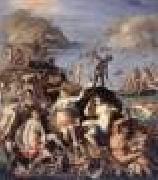 |
ZUCCHI, Jacopo -- Click Here
|
|
Italian Painter, ca.1540-1596. Jacopo Zucchi was an Italian painter of the Florentine school. Italian painter and draughtsman. He was trained in the studio of Vasari, whom he assisted in the decoration of the Palazzo Vecchio, Florence, as early as 1557. He accompanied Vasari to Pisa in 1561, from when dates his earliest known drawing, Aesculapius (London, BM). Between 1563 and 1565 he was again in Florence and is documented working with Vasari, Joannes Stradanus and Giovan Battista Naldini on the ceiling of the Sala Grande (Salone dei Cinquecento) in the Palazzo Vecchio; a drawing of an Allegory of Pistoia (Florence, Uffizi) is related to the ceiling allegories of Tuscan cities. In 1564 Zucchi entered the Accademia del Disegno and contributed to the decorations erected for the funeral of Michelangelo. He travelled to Rome with Vasari and was his chief assistant on decorations in the Vatican in 1567 and 1572, |
|
 |
ZUCCHI Jacopo -- Click Here
|
|
Italian Painter, ca.1540-1596
Italian painter and draughtsman. He was trained in the studio of Vasari, whom he assisted in the decoration of the Palazzo Vecchio, Florence, as early as 1557. He accompanied Vasari to Pisa in 1561, from when dates his earliest known drawing, Aesculapius (London, BM). Between 1563 and 1565 he was again in Florence and is documented working with Vasari, Joannes Stradanus and Giovan Battista Naldini on the ceiling of the Sala Grande (Salone dei Cinquecento) in the Palazzo Vecchio; a drawing of an Allegory of Pistoia (Florence, Uffizi) is related to the ceiling allegories of Tuscan cities. In 1564 Zucchi entered the Accademia del Disegno and contributed to the decorations erected for the funeral of Michelangelo. He travelled to Rome with Vasari and was his chief assistant on decorations in the Vatican in 1567 and 1572, |
|
 |
ZOFFANY Johann -- Click Here
|
|
German/English painter (b. 1733, Frankfurt, d. 1810, Strand-on-the-Green)
|
|
 |
ZIMMERMANN Johann Baptist -- Click Here
|
|
German painter, Bavarian school (b. 1680, Wessobrun, d. 1758, Menchen).
Painter and stuccoist. Much of his early stuccowork and frescoes, such as that in the choir of Gosseltshausen parish church (1701) and the refectories of the abbeys at Tegernsee, Weyarn and Beyharting (before 1710), has been destroyed. His earliest surviving stuccowork (1707-9) is in the pilgrimage church of Maria Schnee, near Markt Rettenbach, and reveals the influences of Johann Schmuzer from Wessobrunn and an Italian stucco workshop that practised in Tegernsee. |
|
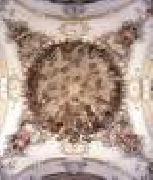 |
ZEILLER, Jakob Johann -- Click Here
|
|
German painter (b. 1708, Reutte, d. 1783, Reutte)
Austrian painter. Trained initially by his father, Paul Zeiller (1658-1738), he subsequently studied in Italy (1723-32) with Sebastiano Conca and at the Accademia di S Luca in Rome, and with Francesco Solimena in Naples, then at the Kaiserliche Akademie in Vienna. From 1733 to 1743 he was a regular collaborator on Paul Troger's frescoes, contributing mainly architectural frameworks painted in the style of the Bolognese quadraturisti. He retained such frameworks in his own paintings throughout his life, even in south Germany where this was generally unusual. Troger's influence on the style of Zeiller's figures and on his iconographic repertory was such that his first independent works in Austria |
|
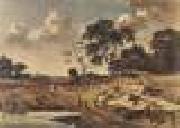 |
WYNANTS, Jan -- Click Here
|
|
Dutch Baroque Era Painter, ca.1630-1684 |
|
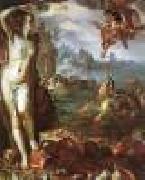 |
WTEWAEL, Joachim -- Click Here
|
|
Dutch painter (b. 1566, Utrecht, d. 1638, Utrecht).
Dutch painter and draughtsman. He was one of the last exponents of MANNERISM. From c. 1590 until 1628, the year of his latest known dated paintings, he employed such typical Mannerist formal devices as brilliant decorative colour, contrived spatial design and contorted poses. He sometimes combined such artifice with naturalism, and this amalgam represents the two approaches Dutch 16th- and 17th-century theorists discussed as uyt den geest ('from the imagination') and naer 't leven ('after life'). Wtewael's activity reflects the transition from Mannerism to a more naturalistic style in Dutch art. Slightly over 100 of his paintings and about 80 drawings are known. Subjects from the Bible and mythology predominate; |
|
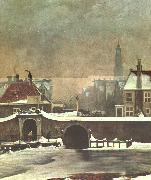 |
Wouter Johannes van Troostwijk -- Click Here
|
|
1782-1810
Dutch
Wouter Johannes van Troostwijk Gallery
Dutch painter, draughtsman and etcher. In 1803 he was admitted to the Amsterdam Tekenacademie where he was a pupil of the director, Jurriaan Andriessen. Despite a highly successful student career that culminated in a gold medal from the Felix Meritis Society in 1807, he was unable to establish himself as a professional artist during the remainder of his very short working life in Amsterdam. Andriessen's studies from nature seem to have been an important influence; van Troostwijk was one of the earliest artists to paint en plein air. Although he looked back to 17th-century Dutch landscape art and to the work of his contemporaries, in such paintings as Landscape in Gelderland (c. 1808; Amsterdam, Rijksmus.; see NETHERLANDS, THE, fig. 21) he achieved a totally new lyricism in the rendering of atmospheric effects. The Raampoortje (1809; Amsterdam, Rijksmus.) displays a fresh colouristic touch rare in Dutch painting of this period. His Self-portrait (c. 1810; Amsterdam, Rijksmus.) is equally original in composition and colour. He also produced animal paintings in the manner of Paulus Potter, drawings and a few etchings towards the end of his life. Van Troostwijk died before his considerable talents could be recognized, and, although he has come to be seen as an important precursor of much late 19th-century Dutch painting, he had little influence on his immediate successors. |
|
|
|
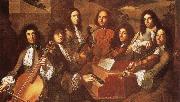 |
william wordsworth -- Click Here
|
|
Born: 7 April 1770
Birthplace: Cockermouth, England
Died: 23 April 1850
Best Known As: The author of the poem "Tintern Abbey"
|
|
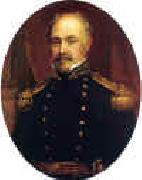 |
William Smith Jewett -- Click Here
|
|
1789-1874
William Smith Jewett Galleries |
|
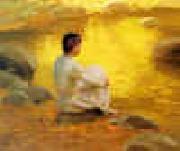 |
William Lees Judson -- Click Here
|
|
1842-1928
William Lees Judson was born in 1842 in Manchester, England, and moved to the United States with his parents when he was ten years old. After serving four years with the Illinois volunteers during the American Civil War, Judson studied art in New York and Paris. He settled in London, Ontario, where he became a successful portrait painter and art teacher. He moved to Chicago in 1890 but, suffering from failing health, he moved to Los Angeles in 1893. He settled on the banks of the Arroyo Seco in the Garvanza section of Los Angeles. A 1937 radio program noted that it was ??love at first sight?? when Judson saw the Arroyo Seco, and the area became his home for the rest of his life. Soon after his arrival, Judson was at the forefront of the Arroyo Guild of Craftsmen, an influential group of artists, sculptors and architects who fueled Southern California??s Arts and Crafts Movement. The beauty of the area stirred Judson to switch from portrait painting to landscapes, and his work attracted such favorable attention that in 1896 he was offered a professorship in drawing and painting at the University of Southern California. In the late 1890s, he founded the Los Angeles College of Fine Arts at his home in Garvanza (the present location of Judson Studios). In 1901, Judson's art college became USC??s College of Fine Arts, with Judson serving as dean from 1901 until his retirement in 1922. He died at his home in the studio building in October 1928. |
|
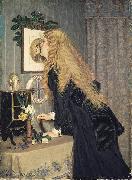 |
William John Hennessy -- Click Here
|
|
(July 11, 1839 - December 27, 1917) was an Irish artist.
William John Hennessy was born in Thomastown, County Kilkenny in 1839. His father, John Hennessy, was forced to leave Ireland in 1848 as a result of his involvement in the Young Ireland movement. He landed in Canada and settled in New York. William, his mother Catherine, and brother joined their father there in 1849. He gained admittance to the National Academy of Design in 1854 and exhibitioned his first works there.
Hennessy developed a skill in wood engraving and was hired to illustrate the works of renowned poets, including that of Tennyson, Longfellow and Whittier. As an American he became the co-founder of the Artists Fund Society, and an honorary member of the American Society of Painters in Watercolours. In 1870 he moved to London where he became a member of the Royal Institute of Oil Painters in 1902. Between 1879 and 1907 the Royal Hibernian Academy displayed eight of his paintings.
|
|
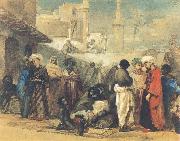 |
William James Muller -- Click Here
|
|
British Painter, 1812-1845, English landscape and figure painter, was born at Bristol, his father, a Prussian, being curator of the museum. He first studied painting under JB Pyne. His early subjects deal mainly with the scenery of Gloucestershire and Wales, and he learned much from his study of Claude, Ruysdael, and earlier landscape-painters. In 1833 he figured for the first time in the Royal Academy with his "Destruction of Old London Bridge--Morning," and next year he made a tour through France, Switzerland and Italy. Four years later he visited Athens, extending his travels to Egypt, and in the sketches executed during this period and the paintings produced from them his power and individuality are apparent. Shortly after his return he left Bristol and settled in London, where he exhibited regularly. In 1840 he again visited France, where he executed a series of sketches of Renaissance architecture, twenty-five of which were lithographed and published in 1841, in a folio entitled "The Age of Francis I. of France." In 1843 he accompanied, |
|
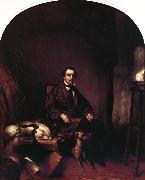 |
William James Hubard -- Click Here
|
|
British/American Artist , Silhouettist , Sculptor, and Scientist , 1807-1862 |
|
 |
William Jacob Baer -- Click Here
|
|
William Jacob Baer (January 29, 1860 - 1941) considered the foremost American miniature painter was born in Cincinnati, Ohio January 29, 1860 and died in East Orange, New Jersey in 1941 |
|
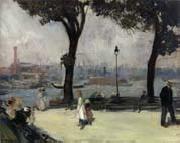 |
William J.Glackens -- Click Here
|
|
March 13.1870-May 22.1938,American painter and illustrator. He graduated in 1889 from Central High School, Philadelphia, where he had known Albert C. Barnes, who later became a noted collector of modern art. He became a reporter-illustrator for the Philadelphia Record in 1891 and later for the Philadelphia Press. In 1892 he began to attend evening classes in drawing at the Pennsylvania Academy of Fine Arts, studying under Thomas Anshutz. In the same year he became a friend and follower of Robert Henri, who persuaded him to take up oil painting in 1894. |
|
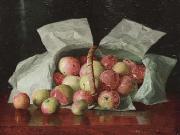 |
William J. McCloskey -- Click Here
|
|
painted Lady Apples in Overturned Basket. Signed W.J. McCloskey in 1941
United States (1859- 1941 ) - Painter |
|
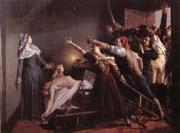 |
Weerts Jean Joseph -- Click Here
|
|
Belgian Academic Painter
1846-Paris 1927
|
|
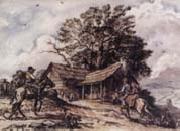 |
Walter Jack Duncan -- Click Here
|
|
He was born in Indianapolis, Indiana .
American, 1881-1941 |
|
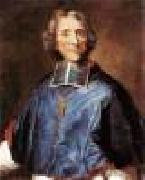 |
VIVIEN, Joseph -- Click Here
|
|
French painter (b. 1657, Lyon, d. 1734, Bonn)
French painter and pastellist, active in Germany. He trained in Paris in 1672 with the painter Fran?ois Bonnemers (1638-89), also attending the Acad?mie Royale, where his oil painting the Punishment of Adam and Eve (untraced) won a second prize in 1678. Only in 1698 was he received (re?u) at the Acad?mie, as a pastellist, on presentation of portraits of the sculptor Fran?ois Girardon and of the architect Robert de Cotte (both Paris, Louvre; see PASTEL, fig. 1). Having been commissioned to execute a pastel Self-portrait (Florence, Uffizi) by Maximilian II Emanuel, Elector of Bavaria, in 1699, the following year he was appointed the Elector's principal court painter (see WITTELSBACH). He henceforth divided his time between Paris, the Elector's courts at Brussels and Munich, |
|
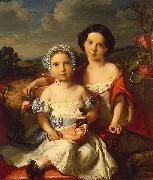 |
Vital Jean De Gronckel -- Click Here
|
|
Vital Jean de Gronckel (1820 - 1890, Belgian) |
|
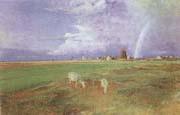 |
Viggo Johansen -- Click Here
|
|
Danish Realist Painter, 1851-1935
Danish painter. He trained at the Kongelige Akademi for de Skenne Kunster from 1868 to 1875 under Jergen Roed. In 1871 he began to visit the fishing hamlet of Hornbek on the north coast of Zealand, not far from Copenhagen, often with painters such as Peter Severin Kreyer and Kristian Zahrtmann. Here Johansen painted pure landscapes, or alternatively figures from the village traditional population, seen in their homes. A Meal (1877; Copenhagen, Hirschsprungske Saml.) shows an elderly fisherman seated at table eating potatoes, attended by his wife; dull daylight from a window in which a net is drying illumines the frugal interior and worn figures. |
|
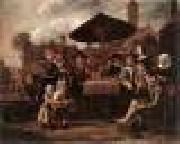 |
VICTORS, Jan -- Click Here
|
|
1619-1676 . Dutch painter.
He was half-brother to the bird painter Jacobus Victors (1640-1705) and the noted Delft potter Victor Victors (b 1638). About 150 oil paintings by Jan Victors, comprising portraits, genre scenes and historical subjects on both canvas and panel, have been catalogued. No signed or securely attributable drawing by him is known. Although his training is undocumented, Victors has long been considered a member of the school of Rembrandt in Amsterdam. His paintings of 1640-70 show many formal and thematic interrelationships with Rembrandt and his documented pupils of the 1630s |
|
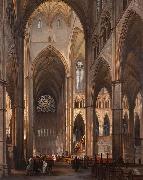 |
Victor-Jules Genisson -- Click Here
|
|
painted Interior of Westminster Abbey in 1851 |
|
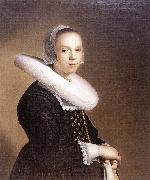 |
VERSPRONCK, Jan Cornelisz -- Click Here
|
|
b. ca. 1597, Haarlem, d. 1662, Haarlem |
|
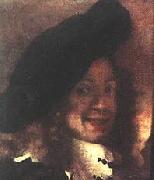 |
VERMEER VAN DELFT, Jan -- Click Here
|
|
Dutch Baroque Era Painter, 1632-1675 |
|
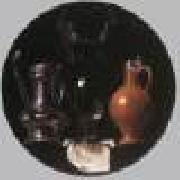 |
TORRENTIUS, Johannes -- Click Here
|
|
Dutch painter (b. 1589, Amsterdam, d. 1644, Amsterdam).
Dutch painter. He was active in Amsterdam, Leiden and Haarlem. In Haarlem in 1627 he was condemned, after severe torture, to 20 years of imprisonment for impiety, blasphemy and his membership of the outlawed Society of Rosicrucians. After having been notified by Sir Dudley Carleton, the British ambassador in The Hague, Charles I of England intervened and brought about Torrentius's release in 1629. Torrentius was subsequently active from 1629 to 1632 in London, which he nevertheless had to leave, again on account of his purportedly immoral mode of life; he returned to Amsterdam. There he was again involved in a trial and died after suffering torture in 1644. His erotic pictures, some of which depicted masterful nudes in mythological settings and are now known only through literary sources, were publicly burnt. A few still-lifes (e.g. Emblematic Still-life, 1614; Amsterdam, Rijksmus.) have survived. These carefully composed works, mostly set before a dark background, recall the work of Jan van de Velde II and the circle of Willem Claesz. Heda. |
|
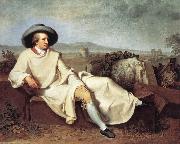 |
TISCHBEIN, Johann Heinrich Wilhelm -- Click Here
|
|
German Painter, 1751-1829 |
|
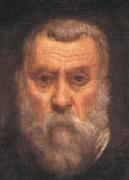 |
TINTORETTO, Jacopo -- Click Here
|
|
Birth Year:, 1518. Death Year:, 1594 |
|
|
|
|
|
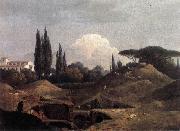 |
Thomas Jones -- Click Here
|
|
Thomas Jones (26 September 1742 - 29 April 1803) was a British landscape painter. He was a pupil of Richard Wilson and was best known in his lifetime as a painter of Welsh and Italian landscapes in the style of his master. However, Jones's reputation grew in the 20th century when more unconventional works by him, ones not been intended for public consumption, came to light. Most notable among these is a series of views of Naples which he painted from 1782 to 1783. By breaking with the conventions of classical landscape painting in favour of direct observation, they look forward to the work of Camille Corot and the Barbizon School in the 19th century. His autobiography, Memoirs of Thomas Jones of Penkerrig, went unpublished until 1951 but is now recognised as a major work of commentary on the 18th-century art world. |
|
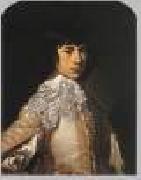 |
TASSEL, Jean -- Click Here
|
|
French Baroque Era Painter, ca.1608-1667
Son of Richard Tassel, with whose works his own were for a long time confused. He trained with his father and by 1634 was recorded in Rome, where he came into contact with his fellow Frenchmen Claude Lorrain, Nicolas Poussin and Sebastien Bourdon. Like the last he was influenced by the Bamboccianti, and he painted a number of low-life genre scenes at this period; these include Singers in a Tavern (Kassel, Schloss Wilhelmshehe) and Travellers Attacked (Warsaw, N. Mus.). He had returned to Langres by 1647, the date of his marriage, and continued to paint genre pictures after this, such as The Sawyers (Strasbourg, Mus. B.-A.) and The Marauders (Langres, Mus. St Didier). Other influences from Rome include Caravaggio, strong in a picture such as the Fortune-teller (sold Paris, Drouot, 1 April 1987, ) but far less apparent in the Presentation of the Infant Jesus (Dijon, Mus. B.-A.) and Tobias and the Angel (Dijon, Mus. B.-A.). However, the most lasting influence was that of the Romano-Bolognese school, seen in later pictures such as the Annunciation |
|
 |
STEINLE, Edward Jakob von -- Click Here
|
|
Austrian painter
b. 1810, Wien, d. 1886, Frankfurt |
|
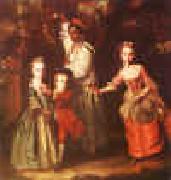 |
Sir Joshua Reynolds -- Click Here
|
|
British
1723-1792
Sir Joshua Reynolds Locations
Reynolds was born in Plympton, Devon, on 16 July 1723. As one of eleven children, and the son of the village school-master, Reynolds was restricted to a formal education provided by his father. He exhibited a natural curiosity and, as a boy, came under the influence of Zachariah Mudge, whose Platonistic philosophy stayed with him all his life.
Showing an early interest in art, Reynolds was apprenticed in 1740 to the fashionable portrait painter Thomas Hudson, with whom he remained until 1743. From 1749 to 1752, he spent over two years in Italy, where he studied the Old Masters and acquired a taste for the "Grand Style". Unfortunately, whilst in Rome, Reynolds suffered a severe cold which left him partially deaf and, as a result, he began to carry a small ear trumpet with which he is often pictured. From 1753 until the end of his life he lived in London, his talents gaining recognition soon after his arrival in France.
Reynolds worked long hours in his studio, rarely taking a holiday. He was both gregarious and keenly intellectual, with a great number of friends from London's intelligentsia, numbered amongst whom were Dr Samuel Johnson, Oliver Goldsmith, Edmund Burke, Giuseppe Baretti, Henry Thrale, David Garrick and fellow artist Angelica Kauffmann. Because of his popularity as a portrait painter, Reynolds enjoyed constant interaction with the wealthy and famous men and women of the day, and it was he who first brought together the famous figures of "The" Club.
With his rival Thomas Gainsborough, Reynolds was the dominant English portraitist of 'the Age of Johnson'. It is said that in his long life he painted as many as three thousand portraits. In 1789 he lost the sight of his left eye, which finally forced him into retirement. In 1791 James Boswell dedicated his Life of Samuel Johnson to Reynolds.
Reynolds died on 23 February 1792 in his house in Leicester Fields, London. He is buried in St. Paul's Cathedral. |
|
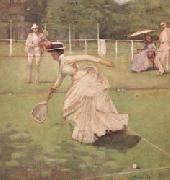 |
Sir John Lavery,RA -- Click Here
|
|
1856-1941
The artist John Lavery was born in Belfast, and studied in Scotland at the Glasgow School of Art from about 1874. He was in London from 1879-81 (he studied at Heatherley's School of Art for six months), and later in Paris, where he was influenced by Bastien-Lepage. He then returned to Glasgow, becoming a leading member of informal group of painters known as the Glasgow School (James Guthrie was another member), with work characterised by lack of a storyline, but great energy. Lavery achieved his pinnacle in the 1880s, with exhibitions in Europe and America, and as a leading portraitist, he was chosen to paint the State visit of Queen Victoria to the International Exhibition in Glasgow, 1888 - there were some 250 portraits in that picture. From 1890 he visited Morocco frequently, and he changed his British base to London in 1896, where he used a studio belonging to Alfred East. He was elected ARA in 1911, |
|
 |
Sir John Lavery -- Click Here
|
|
Irish Painter, 1856-1941
Irish painter. The son of an unsuccessful publican, he was orphaned at the age of three and was brought up by relatives, initially in the north of Ireland and then in Ayrshire. He became an apprentice retoucher to a Glasgow photographer and attended the Haldane Academy, Glasgow, in the 1870s. After spending a winter term at Heatherley's School of Art, London, he moved in 1881 to Paris where he studied at the Acad?mie Julian. At this time he was influenced by Jules Bastien-Lepage and painted in a plein-air naturalist style |
|
|
|
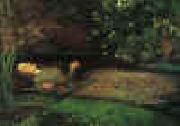 |
Sir John Everett Millais -- Click Here
|
|
British 1829-1896 Sir John Everett Millais Galleries After his marriage, Millais began to paint in a broader style, which was condemned by Ruskin as "a catastrophe". It has been argued that this change of style resulted from Millais' need to increase his output to support his growing family. Unsympathetic critics such as William Morris accused him of "selling out" to achieve popularity and wealth. His admirers, in contrast, pointed to the artist's connections with Whistler and Albert Moore, and influence on John Singer Sargent. Millais himself argued that as he grew more confident as an artist, he could paint with greater boldness. In his article "Thoughts on our art of Today" (1888) he recommended Vel??zquez and Rembrandt as models for artists to follow. The Two Princes Edward and Richard in the Tower (1878) The Boyhood of Raleigh (1871)Paintings such as The Eve of St. Agnes and The Somnambulist clearly show an ongoing dialogue between the artist and Whistler, whose work Millais strongly supported. Other paintings of the late 1850s and 1860s can be interpreted as anticipating aspects of the Aesthetic Movement. Many deploy broad blocks of harmoniously arranged colour and are symbolic rather than narratival. Later works, from the 1870s onwards demonstrate Millais' reverence for old masters such as Joshua Reynolds and Vel??zquez. Many of these paintings were of an historical theme and were further examples of Millais' talent. Notable among these are The Two Princes Edward and Richard in the Tower (1878) depicting the Princes in the Tower, The Northwest Passage (1874) and the Boyhood of Raleigh (1871). Such paintings indicate Millais' interest in subjects connected to Britain's history and expanding empire. His last project was to be a painting depicting a white hunter lying dead in the African veldt, his body contemplated by two indifferent Africans. This fascination with wild and bleak locations is also evident in his many landscape paintings of this period, which usually depict difficult or dangerous terrain. The first of these, Chill October (1870) was painted in Perth, near his wife's family home. Many others were painted elsewhere in Perthshire, near Dunkeld and Birnam, where Millais rented grand houses each autumn in order to hunt and fish. Millais also achieved great popularity with his paintings of children, notably Bubbles (1886) ?C famous, or perhaps notorious, for being used in the advertising of Pears soap ?C and Cherry Ripe. |
|
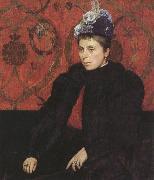 |
Sir james dromgole linton,P.R.I. -- Click Here
|
|
1840-1916 |
|
 |
Sir Edward john poynter,bt.,P.R.A -- Click Here
|
|
1836-1919
English painter, draughtsman, decorative designer and museum official. He came from an artistic family: his great-grandfather was Thomas Banks the sculptor, and Ambrose Poynter, his father, was an architect and watercolour painter. Edward began studying art in 1852 under Thomas Shotter Boys, a friend of his father. In 1853-4 Poynter visited Rome, where he was greatly impressed by the large-scale academic painting of Frederic Leighton. Returning to London, he studied at Leigh's Academy and the studio of William Dobson (1817-1898). Poynter entered the Royal Academy Schools in 1855 but his admiration for French painting led him to Charles Gleyre's studio in Paris the following year. He remained there until 1859, with fellow students George Du Maurier, Thomas Armstrong and Whistler; their activities are described in Du Maurier's novel Trilby (1894). At this time Poynter received his first commissions for decorative work. He began designing stained glass and painting furniture and, after his return to England, he was employed by his friend the architect William Burges to decorate the ceiling of Waltham Abbey, Essex, in 1860. |
|
 |
Sir Edward john Poynter,Bart.PRA,RWS -- Click Here
|
|
1836-1919
|
|
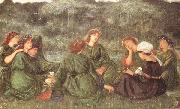 |
Sir Edward Coley Burne-jones,Bart.,ARA,RWS -- Click Here
|
|
1833-1898
|
|
 |
Sir Edward Coley Burne-Jones -- Click Here
|
|
British Pre-Raphaelite Painter, 1833-1898
English painter and decorative artist. He was the leading figure in the second phase of the Pre-Raphaelite movement. His paintings of subjects from medieval legend and Classical mythology and his designs for stained glass, tapestry and many other media played an important part in the Aesthetic Movement and the history of international Symbolism. |
|
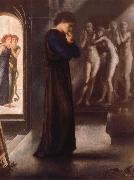 |
Sir Edward Burne-Jones -- Click Here
|
|
Britain 1833-1898
English painter and decorative artist. He was the leading figure in the second phase of the Pre-Raphaelite movement. His paintings of subjects from medieval legend and Classical mythology and his designs for stained glass, tapestry and many other media played an important part in the Aesthetic Movement and the history of international Symbolism. |
|
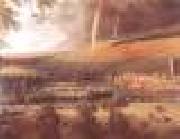 |
SIBERECHTS, Jan -- Click Here
|
|
Flemish Baroque Era Painter, 1627-1703
Flemish painter, active in England. He was the son of the sculptor of the same name and became a master in the Guild of St Luke in Antwerp by 1648. He married in 1652 and moved to England sometime between 1672 and 1674. |
|
|
|
 |
SEISENEGGER, Jacob -- Click Here
|
|
Austrian Painter, ca.1504-1567 |
|
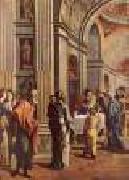 |
SCOREL, Jan van -- Click Here
|
|
Dutch Northern Renaissance Painter, 1495-1562
North Netherlandish painter and ecclesiastic. He was one of the first north Netherlandish artists to visit Italy, and his return to Utrecht in 1524 can be regarded as a turning-point in the history of painting in the northern Netherlands. The important role Scorel played in introducing Italian art in the north was recognized even by contemporary writers and was reiterated slightly later by van Mander |
|
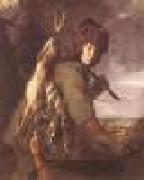 |
SANDRART, Joachim von -- Click Here
|
|
German Baroque Era Painter, ca.1609-1688 |
|
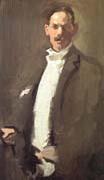 |
Samuel John Peploe -- Click Here
|
|
Scottish Painter, 1871-1935,Scottish painter. He studied at the Royal Scottish Academy schools from 1893 to 1894, and then at the Academie Julian and Acad?mie Colarossi in Paris, where he shared rooms with Robert Brough. The influence of the rustic realism of French painters and of the Glasgow Boys is clear in landscape drawings and paintings executed in Edinburgh from the mid-1890s. His still-life studies reveal the influence of the work of both Manet and Hals, which he saw in European galleries, with their combinations of thick impasto and fluid brushwork, dark background, strong lighting and meticulous handling of tones. Between 1900 and c. 1910, when he moved to Paris, he painted in Edinburgh, on sketching holidays in Scotland and in northern France with John Duncan Fergusson, and exhibited in Edinburgh, Glasgow and London. |
|
|
|
|
|
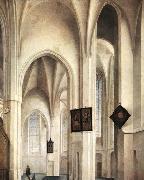 |
SAENREDAM, Pieter Jansz -- Click Here
|
|
Dutch Baroque Era Painter, 1597-1665,Painter and draughtsman, son of Jan Saenredam. His paintings of churches and the old town halls in Haarlem, Utrecht and Amsterdam must have been appreciated by contemporary viewers principally as faithful representations of familiar and meaningful monuments. Yet they also reveal his exceptional sensitivity to aesthetic values; his paintings embody the most discriminating considerations of composition, colouring and craftsmanship. His oeuvre is comparatively small, the paintings numbering no more than 60, and each is obviously the product of careful calculation and many weeks of work. Their most striking features, unusual in the genre, are their light, closely valued tonalities and their restrained, restful and delicately balanced compositions. These pictures, always executed on smooth panels, are remarkable for their sense of harmony and, in some instances, serenity. Here, perhaps, lies a trace of filial fidelity to the Mannerist tradition of refinement and elegance, of lines never lacking in precision and grace. But Mannerist figures and the more comparable components of strap- and scrollwork embellishment lack the tension and clarity of Saenredam's designs, which also have a completeness reminiscent of the fugues of Gerrit Sweelinck (1566-?1628).
|
|
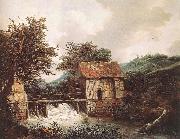 |
RUISDAEL, Jacob Isaackszon van -- Click Here
|
|
Dutch Baroque Era Painter, ca.1628-1682 |
|
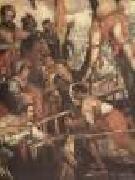 |
ROELAS, Juan de las -- Click Here
|
|
Spanish painter (c. 1560-1625). |
|
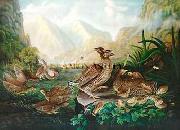 |
Robert Havell Jr Prints -- Click Here
|
|
1793-1878
Engraver and painter, cousin of William Havell. He learnt the art of aquatint engraving from his father, Robert Havell I. He worked first in the family engraving business and then c. 1825-7 with Colnaghi in London. In 1827 he undertook the execution in aquatint of the plates for John James Audubon Birds of America, published in parts in London between 1827 and 1838. Havell engraved 425 of the plates and reworked the ten that had been engraved by William Home Lizars in Edinburgh. Havell father printed and coloured some of the double elephant folio sheets in 1827-8 after which Havell took on those tasks himself, establishing himself as a master of aquatint. Among his other important works in the medium are the plates for Mrs E. Bury Selection of Hexandrian Plants (London, 1831-4). In 1839, at Audubon invitation, Havell moved with his family to New York and embarked on a new career as a landscape painter in the style of the Hudson River school, while also working as an engraver. He settled in the Hudson River villages of Ossining (1841) and Tarrytown (1857) but painted throughout north-eastern America. View of Deerfield, Massachusetts (1847; Hist. Deerfield, MA) is characteristic of his quietly romantic idealization of his subjects. Niagara Falls from the Chinese Pagoda (1845; New York, Pub. Lib.), engraved by Havell after one of his paintings, is among the best known of his American aquatints. Though his reputation rests largely on his work for Audubon, his original subjects gave him greater opportunities to display the full range of his aquatint technique.
Part of the Havell family |
|
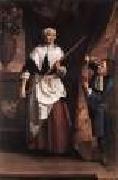 |
RILEY, John -- Click Here
|
|
English Baroque Era Painter, 1646-1691
English painter. He was the son of John Riley of St Botolphs, Bishopsgate, and a pupil of Isaac Fuller and Gerard Soest. He is said to have worked independently for some years, but he made no impact before Lely's death in 1680. Riley maintained a prolific and successful practice as a portrait painter over the next decade against keen foreign competition. |
|
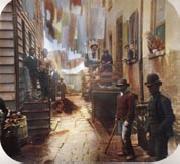 |
Riis Jacob August -- Click Here
|
|
Danish-American journalist and social reformer.
b.1849 d.1914
American photographer of Danish birth. The son of a school-teacher and editor, he was well-educated when he came to the USA in 1870. He was a self-taught photographer and worked at a variety of jobs before becoming a journalist, and he understood the power of the written and illustrated word. Riis's work in journalism began in 1873 when he was employed by the New York News Association. By 1874 he was editor and then owner of the South Brooklyn News. |
|
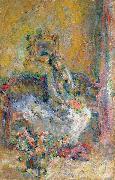 |
Rihard Jakopic -- Click Here
|
|
Rihard Jakopic
Rihard Jakopič (12 April 1869 - 21 April 1943) was a Slovenian painter. He was the leading Slovenian Impressionist painter and theoretician. Together with Matej Sternen, Matija Jama and Ivan Grohar, he is considered the pioneer of Slovenian impressionist painting. |
|
|
|
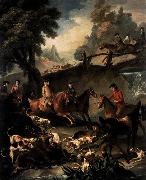 |
REIJSSCHOOT, Pieter Jan van -- Click Here
|
|
Flemish painter
b. 1702, Ghent, d. 1772, Ghent
|
|
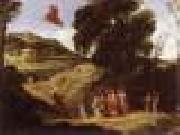 |
PYNAS, Jacob -- Click Here
|
|
Dutch Baroque Era Painter, ca.1585-1650 |
|
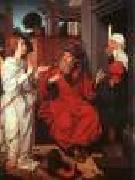 |
PROVOST, Jan -- Click Here
|
|
Flemish Northern Renaissance Painter, 1465-1529 |
|
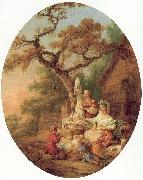 |
Prince, Jean-Baptiste le -- Click Here
|
|
French Painter, 1734-1781
was an important French etcher and painter. Le Prince first studied painting techniques in his native Metz. He then travelled to Paris around 1750 and became a leading student of the great painter, Francois Boucher (1703-1770). Le Prince's early paintings in both theme and style are comparable to his master's rococo techniques. In 1758 Le Prince journeyed to Russia to work for Catherine the Great at the Imperial Palace, St. Petersburg. He remained in Russia for five years and also travelled extensively throughout Finland, Lithuania and even Siberia. When Le Prince returned to Paris in December, 1763, he brought with him an extensive collection of drawings which he employed as the basis for a number of fine paintings and etchings. J. B. Le Prince was elected a full member of the Academie de peinture et de sculpture in 1765. Le Prince's graphic art of Russia and its peoples is significant in that he based his compositions entirely upon his own designs, lending a much more realistic portrayal to his views than other eighteenth century contemporaries. He is also credited with being the first artist (in 1768) to introduce aquatint into his etched and engraved plates. He may even have been the inventor of aquatint, the tonal graphic art that would later be so skillfully used by such masters as Goya, |
|
 |
PORCELLIS, Jan -- Click Here
|
|
Flemish Baroque Era Painter, ca.1580-1632
|
|
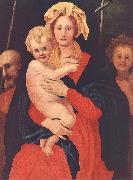 |
Pontormo, Jacopo -- Click Here
|
|
b Pontormo, nr Empoli, 26 May 1494; d Florence, 31 Dec 1556).
Italian painter and draughtsman. He was the leading painter in mid-16th-century Florence and one of the most original and extraordinary of Mannerist artists. His eccentric personality, solitary and slow working habits and capricious attitude towards his patrons are described by Vasari; his own diary, which covers the years 1554-6, further reveals a character with neurotic and secretive aspects. Pontormo enjoyed the protection of the Medici family throughout his career but, unlike Agnolo Bronzino and Giorgio Vasari, did not become court painter. His subjective portrait style did not lend itself to the state portrait. He produced few mythological works and after 1540 devoted himself almost exclusively to religious subjects. His drawings, mainly figure studies in red and black chalk, are among the highest expressions of the great Florentine tradition of draughtsmanship; close to 400 survive, forming arguably the most important body of drawings by a Mannerist painter. His highly personal style was much influenced by Michelangelo |
|
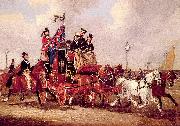 |
Pollard, James -- Click Here
|
|
English, 1792-1867
Painter and etcher, son of Robert Pollard. His early career was spent in the shadow of his father, for whom he worked as an etcher of miscellaneous sporting subjects before establishing himself c. 1820 as a sporting painter in his own right. A typical example is Doncaster Races: Horses Starting for the St Leger (1831; Paul Mellon priv. col.). Following a commission from the King's Printseller, Edward Orme, for an inn signboard showing a coach and horses, Pollard began to specialize in coaching scenes. |
|
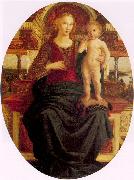 |
Pollaiuolo, Jacopo -- Click Here
|
|
Approx. 1441-1496
Painter, brother of Antonio Pollaiuolo. He was described as a painter in the membership records of the Compagnia di S Luca, which he joined in 1472. According to tradition, he initially trained under Andrea del Castagno. In his 1480 tax return Piero reported that he had a small house adjoining the family home '...which I use when I have painting to do'. He produced many paintings for the Florentine workshop, |
|
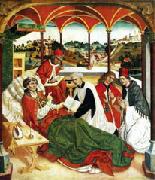 |
POLACK, Jan -- Click Here
|
|
Polish Northern Renaissance Painter, died 1519 |
|
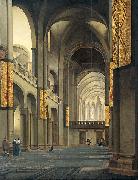 |
Pieter Jansz. Saenredam -- Click Here
|
|
(June 9 1597 - buried May 31 1665) was a painter of the Dutch Golden Age, known for his distinctive paintings of whitewashed church interiors.
Saenredam was born in Assendelft, the son of the Northern Mannerist printmaker and draughtsman Jan Pietersz Saenredam (1565-1607), a follower of Goltzius whose sensuous naked goddesses are in great contrast with the work of his son. In 1612 he moved to Haarlem, where he became a pupil of Frans de Grebber and lived for the rest of his life. In 1614 he became a member of the Haarlem Guild of St. Luke. He died in Haarlem.
A contemporary of the painter-architects Jacob van Campen, Salomon de Bray, and Pieter Post, he is noted for his surprisingly modern paintings of church interiors, the great bulk of his production. Saenredam achieved this modern look by using very even light, subtlely modulated, and by removing detailed depiction of textures, in meticulously measured and drawn sketches. He would make these sketches in pencil, pen, and chalk, then and add in watercolor to help give the sketch texture and color. The sketches are detailed, conveying the interior atmosphere through the clever use of light and graduated shadows. Saenredam often deliberately omitted people and church furniture from work, thus focusing more attention on buildings and their architectural forms. Only after having made precise measurements, and precise sketches and drawings of the churches, he would take them to his studio where he started to create his paintings, often after a delay of many years. His emphasis on even light and geometry is brought out by comparing his works with those of the rather younger Emanuel de Witte, who included people, contrasts of light and such clutter of church furniture as remained in Calvinist churches, all usually ignored by Saenredam. Unlike de Witte's, Saenredam's views are usually roughly aligned with a main axis of the church.
|
|
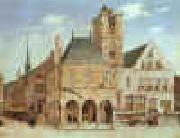 |
Pieter Jansz Saenredam -- Click Here
|
|
1597-1665
Dutch
Pieter Jansz Saenredam Gallery
Saenredam was the son of the print maker and draughtsman Jan Pietersz Saenredam (1565-1607), who was born in Zaandam or, in those days, Saenredam. In 1612 he moved to Haarlem, where he became a pupil of Frans de Grebber and lived the rest of his life.
A contemporary of Rembrandt, he is noted chiefly for his surprisingly modern paintings of churches. Saenredam achieved this modern look by meticulously measuring and making sketches of the churches he wanted to paint. He would make these sketches in pencil, pen, and chalk, then and add in water colors to help give the sketch texture and color. The sketches are very architectural in detail, they convey the interior atmosphere through the clever use of light and graduated shadows. Saenredam often deliberately left people out of his work, thus also focusing more attention on buildings and their architectural forms. Only after having made precise measurements, and precise sketches and drawings of the churches, he would take them to his studio where he started to create his paintings.
The Reformation led to a rise in Protestant art, of which Saenredam??s Interior of the St. Martin's Dom in Utrecht is an example. As a Catholic church the Dom had been built with adornments. Then, in the epoch of the Eighty Years War and with the church getting in Protestant hands, it was ??cleaned?? of Catholic influences. The altarpieces and statuary were removed, and the walls and ceiling were white washed. The painting shows the church not long after its make-over. The sparse interior with illuminated corridors reflect Protestant ideals, new for Saenredam's time.
Alternatively, the paintings of church interiors by Saenredam and other 17th century Dutch painters have been interpreted as having less to do with religion and more with the new-found interest in perspective and with the Dutch interpretation (known as Dutch Classicism) of Palladio??s theories of proportion, balance and symmetry.
In any case, Saenredam wanted to memorialize his country during this time of change by documenting many of the country??s buildings. Many artists before him had specialized in imaginary and fanciful architecture, but Saenredam was the first to focus on existing buildings. According to the J. Paul Getty Trust ??Saenredam??s church paintings??owe their poetry to his remarkable blend of fact and fiction. He began by making site drawings of buildings that record measurements and detail with archaeological thoroughness.?? This meticulous preparation helped him to create such accurate and enchanting paintings. The measurements aided him in using scientific linear perspective, just like Andrea Pozzo. He was able to use his measurements to create a realistic image with depth.
The Utrecht Archives houses a large number of Saenredam's drawings. In the season 2000-2001 the Centraal Museum at Utrecht held a major exhibition of his drawings and paintings. Perhaps his best known works are a pair of oil paintings both titled Interior of the Buurkerk, Utrecht. One hangs in London's National Gallery, the other in the Kimbell Art Museum in Fort Worth, Texas. In their simplicity and semi-abstract formalism, they foreshadow more modern works such as those of Mondrian and Feininger. |
|
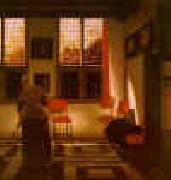 |
Pieter Janssens Elinga -- Click Here
|
|
1623-1682
Dutch
Pieter Janssens Elinga Locations |
|
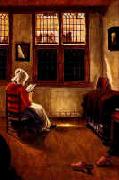 |
Pieter Janssens -- Click Here
|
|
Dutch Baroque Era Painter, 1623-ca.1682 |
|
 |
Pierre-Jacques Volaire -- Click Here
|
|
French Painter, ca.1727-1802 |
|
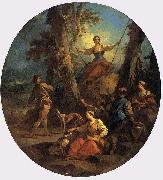 |
Pierre-Jacques Cazes -- Click Here
|
|
(1676-1754) was a French historical painter, known as the teacher of, among others, Chardin. In 1703, he became part of the Academie, was named as director in 1743 and chancellor in 1746. He also worked in the Galerie d'Apollon in the Louvre in 1727 and produced a large number of religious paintings for churches in Paris and Versailles. His historical painting is in the same academic tradition as the French painters Charles Le Brun and Charles de Lafosse. He also painted paintings with mythological motifs and genre scenes. A portrait the artist wearing a wig and holding a portfolio was presented to the Academie Royale in 1734 by Chardin's friend Joseph Aved.
|
|
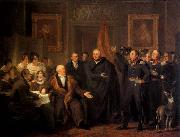 |
PIENEMAN, Jan Willem. -- Click Here
|
|
b. 1779, Abcoude, d. 1853, Amsterdam,Painter, teacher, engraver and museum director. He trained with a wallpaper painter in Amsterdam, and at the same time he followed courses at the Amsterdam Stadstekenacademie, where he soon distinguished himself. His artistic and didactic gifts were recognized by the Napoleonic government, which in 1805 appointed him professor of drawing at the artillery and engineering school in Amersfoort. In 1816 he was appointed assistant director of the Mauritshuis at The Hague by William I. He frequently spent time at the Dutch court, where he gave painting lessons to Queen Wilhelmina and painted many portraits of members of the royal family. He also produced a few engravings. |
|
|
|
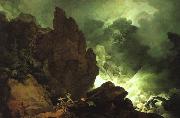 |
Philip James de Loutherbourg -- Click Here
|
|
1740-1812
French (Resident in UK)
Philip James de Loutherbourg Gallery
Philip James de Loutherbourg, also seen as Philippe-Jacques and Philipp Jakob and with the appellation the Younger (31 October 1740 ?C 11 March 1812) was an English artist of French origin.
He was born in Strasbourg, where his father, the representative of a Polish family, practised miniature painting; but he spent the greater part of his life in London, where he was naturalized, and exerted a considerable influence on the scenery of the English stage, as well as on the artists of the following generation. De Loutherbourg was intended for the Lutheran ministry, and was educated at the University of Strasbourg.
As the calling, however, was foreign to his nature, he insisted on being a painter, and placed himself under Charles-Andr?? van Loo in Paris. The result was an immediate and precocious development of his powers, and he became a figure in the fashionable society of that day. In 1767 he was elected into the French Academy below the age required by the law of the institution, and painted landscapes, sea storms, battles, all of which had a celebrity above those of the specialists then working in Paris. His debut was made by the exhibition of twelve pictures, including Storm at Sunset, Night, Morning after Rain.
He is next found travelling in Switzerland, Germany and Italy, distinguishing himself as much by mechanical inventions as by painting. One of these, showing quite new effects produced in a model theatre, was the wonder of the day. The exhibition of lights behind canvas representing the moon and stars, the illusory appearance of running water produced by clear blue sheets of metal and gauze, with loose threads of silver, and so on, were his devices. In 1771 he came to London, and was employed by David Garrick, who offered him £500 a year to apply his inventions to Drury Lane, and to superintend the scene-painting, which he did with complete success, making a new era in the adjuncts of the stage. Garrick's own piece, the Christmas Tale, and the pantomime, 1781-1782, introduced the novelties to the public, and the delight not only of the masses, but of Reynolds and the artists, was unbounded. The green trees gradually became russet, the moon rose and lit the edges of passing clouds, and all the world was captivated by effects we now take little notice of. A still greater triumph awaited him on his opening an entertainment called the Eidophusikon, which showed the rise, progress and result of a storm at sea that which destroyed the great Indiaman, the Halsewell,and the Fallen Angels raising the Palace of Pandemonium. De Loutherbourg has been called the inventor of the panorama, but this honor does not belong to him, although it first appeared about the same time as the eidophusicon. The first panorama was painted and exhibited by Scottish painter Robert Barker. |
|
|
|
|
| | |
|
|
|
|